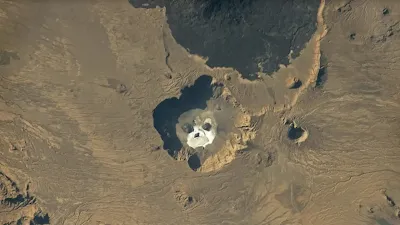In a striking discovery, an astronaut aboard the International Space Station (ISS) captured a remarkable sight while cruising high above the vast Sahara desert.
Let's get into it.
{getToc} $title={Table of Contents}
This intriguing image, shared by NASA Earth Observatory on Halloween, turned out to be anything but paranormal.
Video
On closer inspection, it unveiled an extraordinary geological wonder – the Trou au Natron in northern Chad.
This fascinating observation was made on February 12, 2023, by an ISS astronaut using a Nikon D5 digital camera. The image reveals a gigantic, ghostly skull-like formation that initially baffled many. However, as the details emerged, it was evident that this was not a supernatural occurrence, but a naturally occurring phenomenon.
A Closer Look at the Trou au Natron:
The Trou au Natron is a volcanic caldera of remarkable proportions. It plunges to a depth of 1,000 meters (3,300 feet) and boasts an irregular diameter ranging from 6 to 8 kilometers (4 to 5 miles). Its most striking feature is the layer of white salt covering the majority of the pit's base. This salt layer is known as "natron," a unique mixture of sodium carbonate, sodium bicarbonate, sodium chloride, and sodium sulfate.
{getCard} $type={post} $title={2 Witnesses Identify A Shapeshifter Lady Demands To Disembark}
The Ghostly Resemblance:
The initial comparison to a ghostly skull is not unwarranted. The peculiar shape and stark contrast of the natron-covered crater create an eerie visage when seen from above. Nature's artistry has carved out this extraordinary shape, leading to its ghostly appearance. But rest assured, there are no ancient giants or evil geniuses lurking beneath.
Geological Wonders of the Sahara:
The Sahara desert is no stranger to geological marvels, and the Trou au Natron is yet another testament to the Earth's complex history. The natron layer, formed by the interaction of various sodium compounds over time, adds to the intrigue of this unique formation.
The Mystery Unveiled:
As we celebrate this remarkable discovery, we are reminded that nature often crafts landscapes that challenge our perceptions. While this skull-like formation stirred imaginations, the scientific explanation behind it is equally fascinating. It serves as a reminder that even in the most desolate and remote places on Earth, there are hidden wonders waiting to be unveiled.
In conclusion:
The ghostly skull of the Sahara desert is not a relic of the supernatural, but rather a testament to the Earth's geological diversity. The Trou au Natron is a captivating example of the remarkable beauty and mysteries that our planet holds. It reminds us that, in the quest for understanding, even the most unusual shapes can be deciphered with scientific curiosity and exploration.
Have you ever encountered other mysterious formations in nature that left you in awe? Feel free to share your experiences or ask any questions about the Trou au Natron and Ufology-related phenomena in the comments section below.{alertInfo}
Credit: NASA Earth Observatory/IFLScience/UFO Sightings Footage/UFO Sightings/Ufosfootage/Canva.

